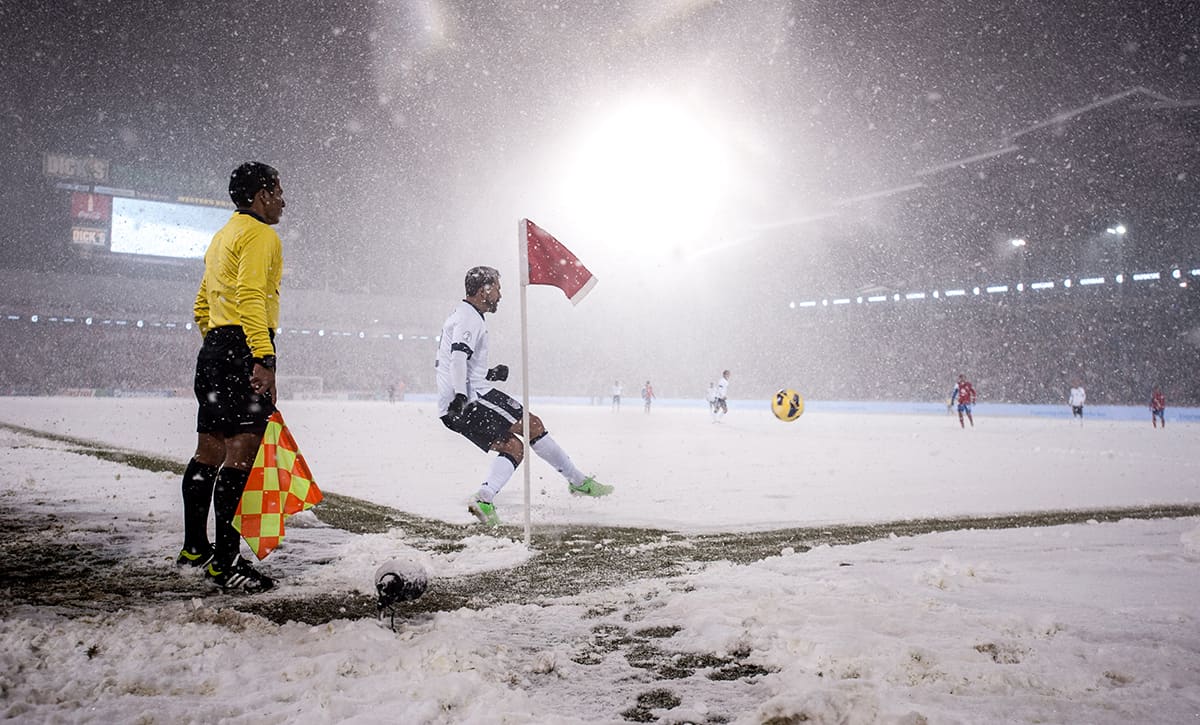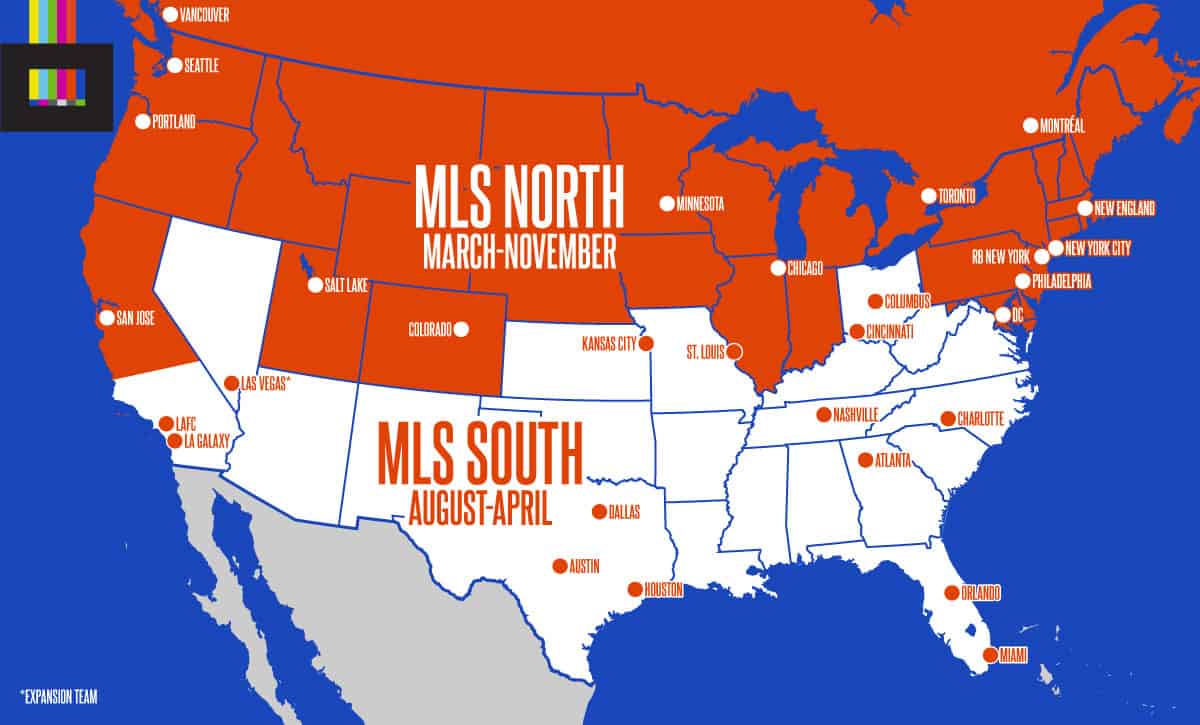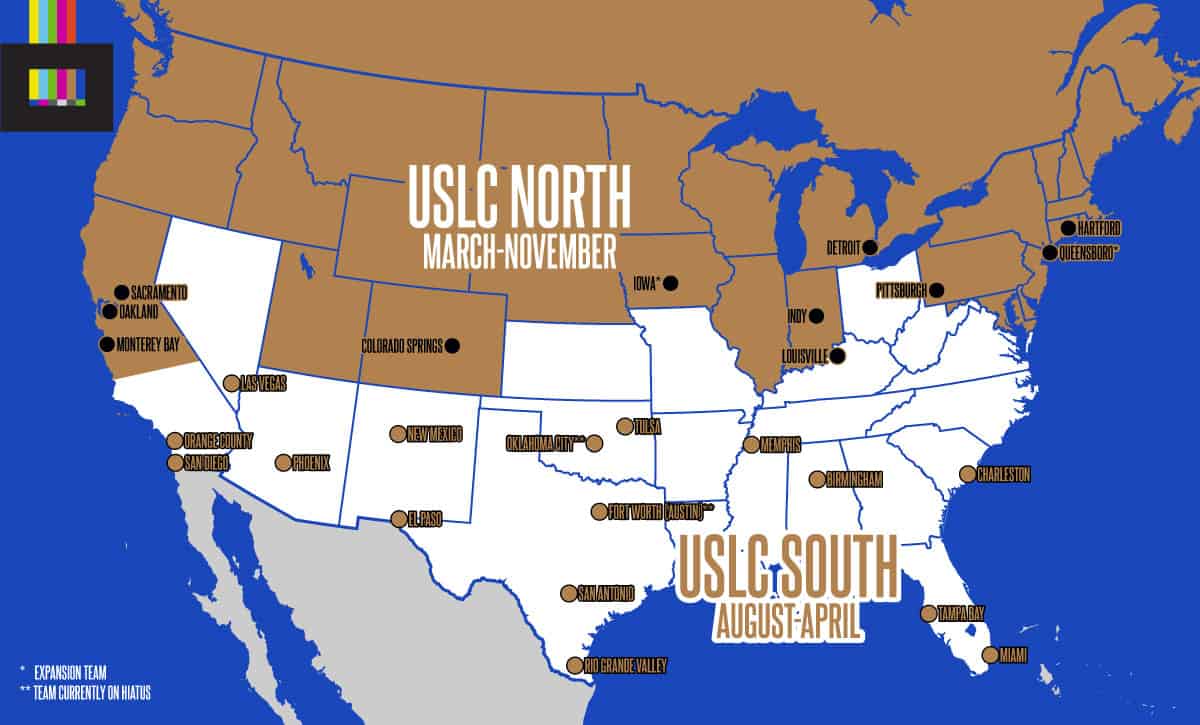 When it comes to how soccer operates in the USA, fans, media, coaches, players, and pretty much everyone involved can have some strong opinions.
When it comes to how soccer operates in the USA, fans, media, coaches, players, and pretty much everyone involved can have some strong opinions.
Indeed, there are two contentious topics that often stir debate in American soccer. First, it’s the promotion and relegation debate. Second, it’s the calendar, whether it should be switched to a Fall to Spring for professional soccer.
I’m not going to dive into the merits of pro/rel today (that being said, #ProRelForUSA).
What I’m going to discuss is the calendar change, how we can do it, and how we can keep everyone happy. But before we get there, let’s look at how things work now, and what the pros and cons of each calendar are.
Pros and cons of the soccer calendars
For the most part, professional, amateur and collegiate soccer in the USA has always been played from the Spring to the Fall, with specific dates varying depending on the specific competition. Playing during this time of year is primarily the law of the land for one reason – teams in the northern reaches of the country simply can’t play outdoors during harsh winter conditions.
The trade off is that teams in southern locations, particularly the southeast, Florida, and Texas, are forced to play through oppressive heat and rain over the summer months. Of course, elsewhere in the country it can get pretty darned unpleasant at times in the summer too, but it’s the worst in those spots.
The Summer Schedule
The way we run our leagues now, things go from about February to November (roughly the MLS season, with the lower divisions and NCAA schedules falling somewhere within that same window). This saves the likes of New England, Montréal, Minnesota et al from having to break out the hi-vis balls and play in the snow and bitter cold of the worst of winter in the northeast and midwest.
Avoiding the cold in the north means embracing the punishing heat of the south. Many games (including far too many puzzling afternoon kickoff times in MLS) are played in 90°F+ heat, with brutal humidity, requiring hydration breaks for the players. And with the sun out later during the summer, even 7-8PM kickoffs can be affected by hot temperatures, awkward lighting conditions and uncomfortable conditions for fans and players alike.
Another issue, particularly in the Southeast, is frequent severe summer thunderstorms that can create dangerous pitch conditions, and cause delays and/or match postponements. And along the coasts, tropical weather can rear its ugly head, with tropical storms and hurricanes potentially cancelling matches and disrupting team travel.
I’ve personally sat through far too many rain and/or lightning delays (including a match cancellation after traveling 4 hours across the state with a bus full of supporters for an away game), and brutally hot summertime games over the years. Every December and January, as we enjoy gorgeous 60°F and 70°F temperatures with clear skies and low humidity here in Florida, I think to myself “It’s incredibly stupid we can’t have pro soccer games right now, simply because places 1,000 miles away like Minnesota can’t”.
Proponents of the summer schedule will argue that it also keeps soccer from having to compete with other sports for fan/media eyeballs and dollars, by playing in their offseason – namely the NFL and NCAA football. However, this is a flimsy at best argument, as the Spring-Summer-Fall soccer season still overlaps with every major pro sport, including the entirety of the professional MLB/MiLB baseball seasons (that have games every single day). The end of the pro soccer seasons, including playoffs and championship games, still go head to head with NFL/NCAA football every weekend from late August on, along with heavy overlaps with the NBA and NHL at the start and end of each season.
The Winter Schedule

The “Snow Clasico” was one of the most memorable and fun moments in US Soccer history, but you probably wouldn’t want to have a large chunk of your league schedule in conditions like this. Photo credit: Getty Images
The alternative is the European calendar, a Fall-Spring setup that, under most proposals, would begin in or around August and run through late Spring.
The overlap with other sports would flip around, avoiding the middle chunk of the baseball season, but catching most of the NFL, NCAA football, NHL and NBA schedules. But your playoffs and cup finals would no longer be head to head with football and MLB playoffs, instead slotting in with early round NBA/NHL playoffs as the main competition in the Spring.
The main problem with the Euro schedule of course is the possibility of snow, sleet, and freezing (or sub-freezing) temperatures, specifically in the northern extremes and the midwest areas around the Great Lakes. There have been a few memorable moments in these sorts of conditions over the years, but for the most part, it’s doesn’t make for proper playing conditions, and many fans would be staying home (though across the country each year, it never stops people from bundling up and selling out NFL games in blizzard conditions).
One of the main benefits touted of the Fall-Spring format is a better alignment with the international soccer calendar. Losing less players to international call-ups during the season, not needing to break for (or play through) the major summer tournaments, and having an easier time with transfers and player contracts when buying and selling overseas. And of course, you avoid the hot summer conditions in much of the country by skipping the worst of the summer weather.
An issue arises in most Fall-Spring proposals, as to make it physically possible for the northern teams to play, you need a substantial break in the season sometime during December/January/early February. This is also usually coupled with the idea that the schedule around the break can be crafted in such a way that the northern teams play mostly on the road in the fringe months – but this creates a competitive imbalance to the overall season with front- and back-loaded home schedules, depending on the team.
Also, the break itself completely wastes the absolute best weather conditions in the southern areas, losing out on a big positive of the calendar switch. USL’s planned Super League, a Division 2 women’s pro league, plans to operate in this fashion, on an August to June schedule with a break, when it launches in 2023-24. Both the NASL (2011-2017) and NISA have experimented with split season formats, somewhat similar to the Apertura/Clausura setup seen in many Latin American leagues, but both involved long winter breaks and relatively shorter summer breaks, and mostly mirrored the standard Spring-Fall calendar.
Why Not Both?
No matter which way you flip the calendar, somebody inevitably gets left out in the cold (or heat, as it were).
The solution, that would better serve every club throughout the country, is something I’ve never seen anyone but myself even consider: split our league(s) into independent north/south regions that play on different schedules, each best suiting their own geographic situation.
Maybe it’s because all of our other major sports leagues are structured one way, maybe because pretty much every league around the world is a singular entity that covers a whole country, but we take it as a given that there can only be one league with a single schedule for the whole country (or when it comes to MLS, two countries) and nobody questions the logic in that. But if you think about it, it really doesn’t make any sense at all.
The United States (and Canada) is unlike any other soccer nation on Earth. No other league system covers such a vast geographic area, with significant differences in climate from location to location, and a relatively even population distribution. The larger nations that compare closest to the US in terms of overall square miles – namely Russia, Brazil, China and Australia – all have the bulk of their teams in a relatively close geographic cluster, and thus more consistent climate conditions to deal with. So nobody in those leagues is getting thrown to the wolves when it comes to playing conditions, everyone is more or less on the same page and the schedule format makes sense for everybody.
If each of the US states, or perhaps broader geographic subregions, had their own FAs and league systems, there is absolutely no way they would all be playing during the same time of the year. A league of Florida-based teams wouldn’t have to worry about the playing conditions in December in Toronto, so naturally they’d make the sane choice, and play during the pleasant subtropical Winter. Conversely, a Great Lakes League wouldn’t even consider playing over the frigid Winter, so they’d play during the Summer.
In addition to the climate benefits such a restructuring would bring to clubs, you’d have the overall benefit of the highest levels of the game being played year round, getting domestic soccer on TV screens throughout the full calendar year, and giving domestic players the ability to stay (relatively) close to home playing all year long (I could see a lot of interleague loans happening). You’d also get at least a minimal logistical benefit, with somewhat less taxing travel for both the clubs themselves and traveling supporters in the more regionalized setup. Los Angeles and Montréal are nearly 2,500 miles apart. Miami and Vancouver, almost 3,000 miles. It makes zero sense for all of those teams to be part of the same domestic league schedule.
One of the reasons our other pro sports leagues span the entirety of the continent is for TV purposes – needing the “big ticket” major markets all included, such as LA, New York, Chicago and Miami. That may be valid when you’re talking about the likes of the Lakers, Yankees, Cubs and Buccaneers. But when it comes to soccer, national ratings for MLS have never really been great, and matchups featuring big market teams don’t perform notably better than say, Cincinnati vs. Real Salt Lake does.
And oftentimes throughout our pro soccer history, support/attendance in the bigger markets has been sub-par as well. How many times have you tuned into a nationally broadcast MLS game, only to be able to make out most of the Red Bull logo in the empty seats? It’s well documented that the smaller markets have produced more engaged fanbases and better quality atmospheres in their stadiums (with LAFC perhaps being the first real breakthrough when it comes to an atmosphere in a top 3 market). That all being said, at the end of the day each league would still have the full suite of markets in their portfolio to sell to potential TV partners – you just wouldn’t be able to slot in any Philadelphia vs Dallas matchups for a 1:00 PM Saturday kickoff on ESPN.
Both Major League Soccer and the USL Championship have the critical mass of teams needed to implement such a split system themselves, with no intervention from the USSF required. So let’s imagine how it might actually look:
MLS

To round out the numbers, I’ve added a 30th MLS team in Las Vegas, which seems to be a popular pick for that spot.
What you end up with is two leagues of 15 teams each. Much like East/West conference alignments, there are some border teams that could go either way, but for example’s sake let’s say it’s split up like this.
Each league could play a double round robin, 28 game schedule, with home and away games vs every other team in their respective league. Cap that off with say, a 4 team playoff at the end of each season and you’ve got what is still a very compelling competition. This is a reduction of league games compared to now, but the extra breathing room would allow for Champions League, Leagues Cup, and Open Cup to slot in more comfortably and ease schedule congestion. Speaking of the Open Cup, early rounds in the late Spring and later rounds in the early Fall, when both seasons overlap and everyone is playing, would make sure nobody gets caught playing during the offseason.
In MLS, teams already don’t play every other team at least once a season, so you’re not losing anything there. Only seeing certain other domestic teams in Cup competitions or continental play would give extra weight to those fixtures, making it a special occurrence. In the NFL, LA doesn’t play New York or Chicago every season, and the fans and TV executives all get by just fine.
Now let’s see how the second division could shake out:
USL

The USL Championship presents an opportunity to showcase another benefit of a split league/season setup: flexibility. Counting all the existing independently-owned teams (the handful of remaining MLS-owned teams are all eventually leaving to MLS NEXT Pro anyway), plus the two on hiatus and two planned expansion teams, USLC is at 27 teams. That makes for an uneven split, but due to geography it makes things even tougher, as USL is more populated in the South.
So what I’ve done here is create a Northern league with 11 teams, and a Southern league with 16. The Northern league could play three games vs each other team in the league for a total of 30 (alternating each year who gets the two home games in each matchup), while in the South they would play a simple double round robin, for the same 30 games.
With the regions being operationally independent, each can have its own format that best suits the number of teams competing, adjusting when needed as they grow.
It gets harder to illustrate things when you go down the third division, due to the three separate leagues operating at that level. Division three, and below into the amateur levels, could certainly benefit from a unification and reorganization into simple geographic regions, each of which could adopt to whichever season fits them best. Amateur leagues like the NPSL, UPSL, and USL League Two are all already setup into nice small regional conferences, so it would be easy for something like the NPSL Sunshine Conference in Florida to move to a winter season (well, except for the fact that they rely almost exclusively on NCAA players who are only available in the summer, but that’s another issue altogether).
At each level on the pyramid, it would be fun to have a “Super Cup” between the champions of each league, but the way the seasons would overlap would make deciding the timing of such a match difficult. Instead however, those champions meeting up in Concacaf Champions League and the US Open Cup would add further intrigue and excitement to those competitions.
The bottom line is that we can have a league system that works better for everybody, without forcing a one-size-fits-all schedule solution onto an entire continent, which inevitably puts a large chunk of players and fans at a disadvantage regardless of which way you go. A split calendar league setup would produce better conditions for players and fans in many markets, potentially improve attendance and atmosphere, and I think be an overall net gain for the sport in this country. We just have to get past the “One Country One League” mental block, and be willing to try something a bit unorthodox.
200+ Channels With Sports & News
- Starting price: $33/mo. for fubo Latino Package
- Watch Premier League, World Cup, Euro 2024 & more
Live & On Demand TV Streaming
- Price: $35/mo. for Sling Blue
- Watch Premier League, World Cup & MLS
Many Sports & ESPN Originals
- Price: $9.99/mo. (or get ESPN+, Hulu & Disney+ for $13.99/mo.)
- Features Bundesliga, LaLiga, Championship, & more
2,000+ soccer games per year
- Price: $4.99/mo
- Features Champions League, Serie A, Europa League & NWSL
175 Premier League Games & PL TV
- Starting price: $4.99/mo. for Peacock Premium
- Watch 175 exclusive EPL games per season
110+ channels, live & on-demand
- Price: $59.95/mo. for Plus Package
- Includes FOX, FS1, ESPN, TUDN & more






















Nereo
August 12, 2022 at 1:58 pm
Another solution is to make two short tournaments. Each winner plays a final o determine the champion of season
Dates would be:
For the first tournament: Mid august to end of november
For the second tournament: First day of march to third week of june.
The final: Last week of june
Buckles
June 9, 2022 at 10:24 am
They have to do something bc the calendar can’t stay the way it is. On a regular year, a team could go from October to February with no action. That’s just too long and hurts the national team and the players form.
32 teams is a lot but I assume you want that for the even number amount of teams in each conference. I agree. Or do full single table but that hurts the playoff system which is an enjoyable part of the season.
Jasinho
June 7, 2022 at 4:40 pm
There are a whole lot of moving parts with a calendar change proposal for MLS. There would not only be a huge benefit from aligning to an August-May calendar, but would enable a lot more club friendlies with European sides, the end of season can coincide with the CCL final, and allow more flexibility for scheduling of the Leagues Cup in cases of conflict with the World Cup and other international tournaments.
There is a lot of validity to scheduling games according to geography to minimize any inclimate weather scenarios, such as matches up north in the winter. I think that is feasible if MLS goes legitimate single table, then there could be more flexibility to concentrating games based on likely weather, perhaps a single table would even improve the MLS Cup at the end of the season. 29 games against playing all teams once plus one derby match would bring to 30 before the MLS Cup playoffs.
Yespage
June 7, 2022 at 9:14 am
Likely need a modified set-up. Playing soccer in the Northeast/Midwest between December and March will be rough and unpredictable. It’d probably make sense to have a two month break (January / February), and then weigh the home games outside the remainder of the not nice weather (December / March). As far as playing in the South in the summer, baseball does it, it can be done with soccer. And they manage 162 game seasons despite the weather.
Regarding promotion/relegation, people need to just let that go. It isn’t happening.
Buckles
June 7, 2022 at 9:29 am
The exertion involved in baseball compared to soccer is very different. Baseball is a summer sport. That being said, I agree that with a break in January and February, you can definitely do a fall to spring schedule. It’s a must to change the calendar. And it can be done. Pro/rel is never going to get done.
Ra
June 7, 2022 at 9:47 am
I did not read the article, but based on the comments, it seems simpler to me – play all home games in the North on summer, and vice-versa on winter.
But the other issue is lack of true rivalries- more than 1 team is needed in a city or region to spark rivalries. But it is impossible to inflate the league enough to accommodate it.
Paul
June 6, 2022 at 9:54 pm
There are plenty of European leagues that play August to May with a winter break which could range from 3 weeks to 3 months. As long as league sizes are small enough to allow a full fixtures list then this system would work on a national basis.
Ricco Richardson (CrunkATL)
June 6, 2022 at 8:13 pm
This proposal is so Stupid not only isn’t consistent it’s just makes the league’s less legitimate in North America and will further Kill the leagues!
Buckles
June 6, 2022 at 3:37 pm
I like that there are new ideas being put out there. This is an interesting idea. I still think you don’t have to “split” into 2 regions. An August to May schedule would work if you include a decent break in maybe January and February. It can be done. It should at least be tried.
JP
June 6, 2022 at 3:08 pm
Edit, not a pod, but this article.
JP
June 6, 2022 at 3:08 pm
https://worldsoccertalk-wp.futbolsites.dev/2022/04/12/mls-change-regular-season-tv-ratings/
JP
June 6, 2022 at 3:02 pm
You’re not the only one with this sort of idea! Here’s my comment to the April 12th podcast…
–
“I’ve posted this idea somewhere here before, but applies to this. MLS should split up into regions. Think college conferences in the 80’s to early 90’s before realignment made them geographically nonsensical.
–
One region could encompass New England, NY, Pennsylvania, NJ, possibly DC. Another could be Virginia, Carolinas, Georgia, and Florida, etc.
–
Within these regions existing MLS clubs along with USL or other lower divisions could have clubs fill in order to get 15-20 clubs per region.
–
There would be pro/rel in each region, and top places would qualify for an in season champions league type tournament for the following season with the other regions. Just like Europe.
–
This allows the introduction of pro/rel but the bigger (exising MLS clubs) know they have little risk of being relegated given their financial/market advantages.
–
This allows for each region to tweak their own calendar slightly to make it most advantageous based on their climate. Could mirror the international calendar more closely, but colder climates could incorporate a longer winter break, etc.
–
The in season champions league type tournament would still allow the bigger markets (assuming they qualify) around the entire country to play each other, which the television/streaming companies would want.
–
The regional format could create more natural rivalries, and given that MLS is already mostly a regional sport in terms of interest, helps accentuate that aspect.
–
Discuss!”
dave
June 6, 2022 at 3:37 pm
@JP, I like your idea and I like Derek’s idea. Accounting for different climates by region seems smart. Consistent home-and-home each calendar year against a smaller subset of teams might strengthen rivalries organically. Cross-country games can be an occasional treat in pre-defined windows which might drive ratings. Etc.
.
I am less sold on adding USL and pro/rel since it is a separate can of worms with USSF and MLS. It might kill single-entity which I suspect is a non-starter with investors who bought in for hundreds of millions to a single-entity. Does a “relegated” MLS investor keep their share of SUM? TV revenue? Expansion fees? “Their” players who are under contract with MLS? Etc.
.
You and I commented in the podcast thread about Univision’s feedback on MLS as shared by Felipe. I hope MLS take that to heart as they consider their go-forward model. Seems they may be cruise-controlling to 32 teams in 2 conferences, 7 teams per conference make a single-elimination playoff. I am not convinced copying the NFL model is optimal for MLS
JP
June 6, 2022 at 4:23 pm
@dave, I agree it would be extremely difficult to convince current MLS owners to adopt some pro/rel model. Partially why I’d go with many regions and not just two as layed out in this article. Make it almost impossible for the larger markets (MLS teams) to get relegated in a 15-20 club region where maybe five to six clubs are from MLS and the rest from what were lower divisions….unless they F up in epic ways. In that case, they’d deserve it!
–
Also agree they shouldn’t copy some NFL format. There is only one NFL, accept it. NFL is one game a week for pretty much 4 months a year. NFL and College football very unique in their structure with low number of games and unbalances schedules. Cannot be replicated to other leagues.
B
June 6, 2022 at 8:45 pm
Weather and ambient temperature are not completely latitude dependent. Sacramento in the North is a non-starter. Maybe you need to more consider frost zones. The Bay Area gets virtually no snow…
Turfit
June 6, 2022 at 8:51 pm
Another thought (after watching the state football leagues in Brazil this spring), MSL could have a spring and fall season. Summer break and Winter break with “State Leagues” that is regional playing during the breaks, northern teams playing in the summer and southern teams playing in the winter.
But MLS has too many NFL owners and commissioner is NFL, I do not believe that the MLS will ever change. I’m now thinking our focus should be to change USL and changing the calendar for “easier time with transfers and player contracts when buying and selling overseas” and adding Pro/Rel, USL could become top level soccer in US.
Jeremy
June 8, 2022 at 12:19 pm
The only way MLS is going to be regionalized is if they keep doing what they are doing now (East and West). No need to completely overhaul everything, that North and South split sounds ridiculous. What MLS should do is get to 32 teams and continue to divide between East and West. Teams would play 30 games within their conference (15 home and 15 away) and play 4 games against teams from the opposite conference (over the course of 4 years, a team would have played every team from opposite conference). With all that being said, I wouldn’t mind moving to a fall/spring schedule. Like everyone else said, it would help line-up with international transfer market and I doubt tv ratings would be an issue these days. I also would like to line up better with the FIFA calendar.